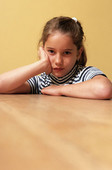
THURSDAY, March 14 (HealthDay News) — Children who avoid scary situations are more likely to have anxiety, according to researchers who developed a new way to assess avoidance behavior in youngsters.
The Mayo Clinic study included more than 800 children, aged 7 to 18, and used two eight-question surveys, one for parents and one for children.
The parents’ survey asks about their children’s tendencies to avoid scary situations. For example: “When your child is scared or worried about something, does he or she ask to do it later?”
The children’s survey asks them to describe their avoidance habits. For example: “When I feel scared or worried about something, I try not to go near it.”
Children who tried to avoid scary situations at the start of the study were more likely than other children to have anxiety a year later, according to the study published online March 4 in the journal Behavior Therapy.
“This new approach may enable us to identify kids who are at risk for an anxiety disorder,” study lead author Stephen Whiteside, a pediatric psychologist with the Mayo Clinic Children’s Center, said in a Mayo news release.
“And further, because cognitive behavior therapy focuses on decreasing avoidance behaviors, our approach may also provide a means to evaluate whether current treatment strategies work [the way] we think they do,” he added.
Whiteside said 25 children with anxiety underwent counseling that slowly exposed them to situations that caused fears. This led to a decline in their avoidance scores.
“Kids who avoid fearful situations don’t have the opportunity to face their fears and don’t learn that their fears are manageable,” Whiteside explained.
More information
The Nemours Foundation has more about anxiety, phobias and fears in children.

